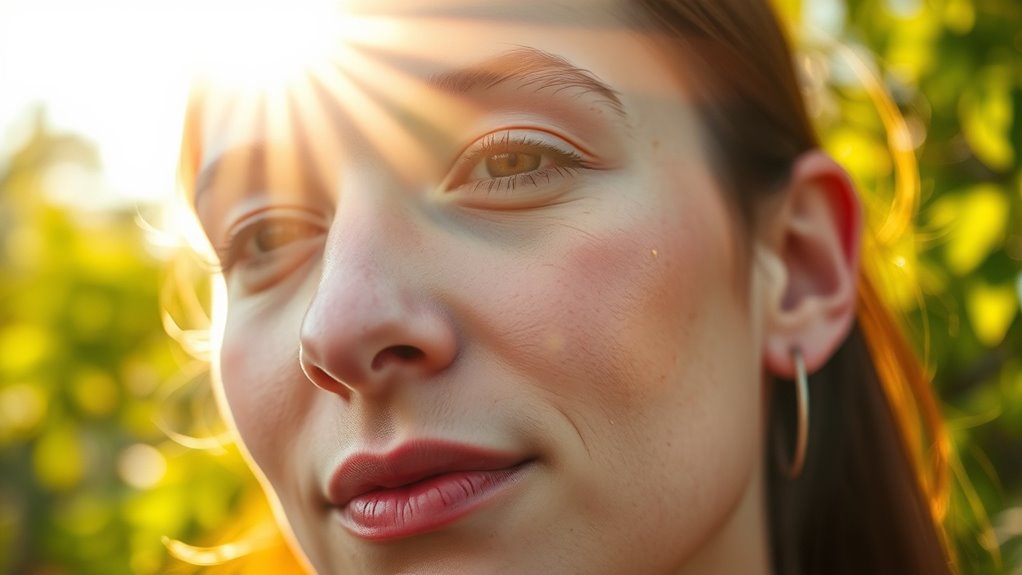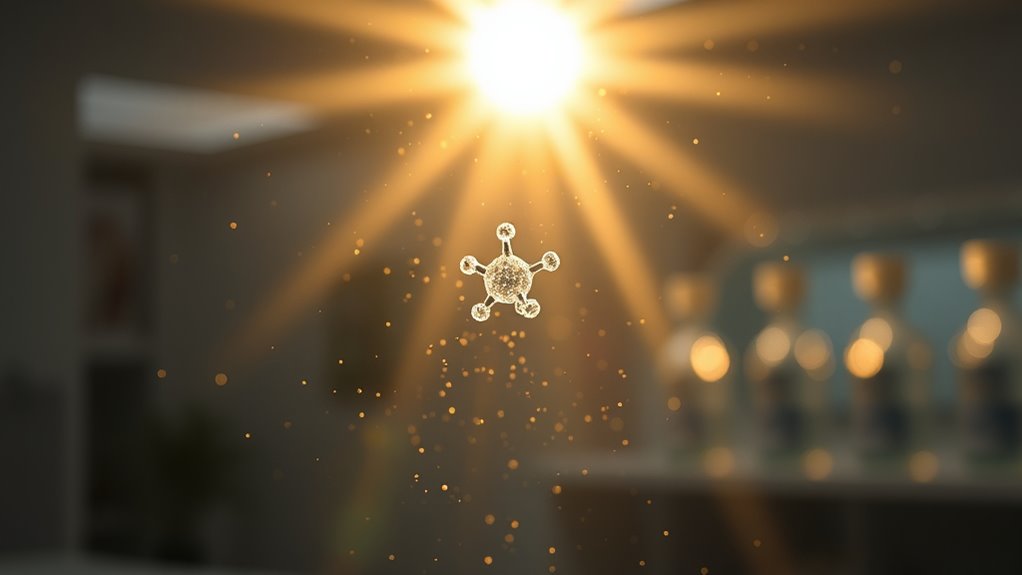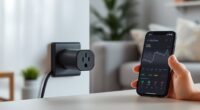Micro-dosing sunlight works by safely triggering your skin’s natural process of producing vitamin D3 through brief, controlled UV exposure. When exposed, your skin converts cholesterol into vitamin D, influenced by factors like skin type, time of day, and exposure duration. This method minimizes skin damage risks while supporting overall health. If you explore further, you’ll discover how personalized strategies can optimize your vitamin D levels effectively and safely.
Key Takeaways
- Micro-dosing sunlight activates skin synthesis of vitamin D3 through brief, controlled UV exposure, mimicking natural production processes.
- Factors like skin type, pigmentation, age, and time of day influence the efficiency of vitamin D synthesis during micro-dosing.
- Short, regular UV exposures reduce skin damage risk while maintaining steady vitamin D levels essential for health.
- Controlled micro-dosing aligns with the body’s natural vitamin D production, optimizing benefits such as immunity and bone health.
- Advances in research help tailor personalized, safe sun exposure guidelines to maximize vitamin D benefits while minimizing risks.

Many people struggle to get enough vitamin D, especially during the winter months or in urban environments with limited sun exposure. This deficiency can lead to weakened bones, immune problems, and fatigue. To combat this, some are turning to micro-dosing sunlight—small, controlled amounts of UV exposure aimed at boosting vitamin D levels without risking skin damage. The core science behind this approach hinges on understanding how your skin synthesizes vitamin D when exposed to sunlight.
Many struggle with vitamin D deficiency; micro-dosing sunlight offers a safe way to boost levels naturally.
When UV rays hit your skin, they trigger a chemical reaction that converts a form of cholesterol present in your skin into vitamin D3. This process, called skin synthesis, is your body’s natural method for producing vitamin D. The amount of vitamin D generated depends on factors like the intensity of UV exposure, the duration of exposure, skin type, and the time of day. Short, regular doses of sunlight can stimulate this synthesis efficiently, providing a steady supply of vitamin D without overexposure.
Micro-dosing techniques are designed to harness this natural process safely. Instead of prolonged sunbathing, you spend just a few minutes outside each day, exposing the skin to a modest amount of UV rays. This approach minimizes the risk of skin damage while still encouraging vitamin D production. The key is to find the right balance—enough UV exposure to activate skin synthesis but not so much that it causes burns or long-term skin issues.
Your skin’s ability to produce vitamin D varies based on factors like pigmentation and age. People with darker skin need longer exposure to produce the same amount of vitamin D as lighter-skinned individuals because melanin, the pigment that darkens the skin, acts as a natural sunscreen. Similarly, as you age, your skin becomes less efficient at synthesizing vitamin D, so micro-dosing might need adjustment to accommodate these differences.
Understanding the science behind UV exposure and skin synthesis helps you make informed decisions about sun habits. By adopting a micro-dosing strategy, you can optimize vitamin D production in a safe, controlled manner. This method aligns with your body’s natural processes, allowing you to maintain adequate levels without risking skin damage. Additionally, advances in sun exposure research continue to refine safe practices for vitamin D synthesis, making micro-dosing a more effective and personalized approach. Ultimately, it’s a practical way to harness the power of sunlight, especially when full sun exposure isn’t feasible, helping you stay healthier and more resilient year-round.
Frequently Asked Questions
How Does Skin Type Affect Vitamin D Synthesis From Micro-Dosing Sunlight?
Your skin type influences vitamin D synthesis because skin pigmentation affects UV sensitivity. If you have darker skin, higher melanin levels reduce UV penetration, making micro-dosing sunlight less efficient for vitamin D production. Conversely, people with lighter skin have less melanin, increasing UV sensitivity and boosting vitamin D synthesis with less sun exposure. Adjust your micro-dosing approach accordingly to optimize vitamin D levels based on your skin pigmentation.
Can Micro-Dosing Sunlight Prevent Vitamin D Deficiency in Winter?
Micro-dosing sunlight can help prevent vitamin D deficiency in winter by ensuring consistent Vitamin D absorption, despite sunlight variability. You benefit from short, regular exposures that boost your levels without risking skin damage. This approach allows your body to adapt to seasonal changes, maintaining ideal vitamin D levels year-round. Just remember, the effectiveness depends on your skin type and how much sunlight you get during these micro-doses.
What Is the Optimal Time of Day for Micro-Dosing Sunlight?
For ideal timing optimization of sun exposure, aim for morning hours when UVB rays are stronger and less harmful. Exposing your skin for about 10-15 minutes between 8 and 10 a.m. helps your body produce vitamin D efficiently without overdoing it. This window balances effective sun exposure with safety, ensuring you get enough vitamin D without increasing skin damage risk. Adjust based on your skin type and local sunlight conditions.
Does Artificial Light Mimic the Effects of Natural Micro-Dosing Sunlight?
Artificial light can mimic natural sunlight’s effects, but it depends on the light spectrum and your skin pigmentation. Full-spectrum or UVB-emitting lights come closest, helping your skin produce vitamin D similarly. However, if your skin pigmentation is darker, you might need more exposure or specific light wavelengths. While artificial light can support vitamin D synthesis, it may not perfectly replicate the benefits of natural micro-dosing sunlight.
Are There Risks Associated With Excessive Micro-Dosing Sunlight Exposure?
You should be aware that excessive micro-dosing sunlight can increase sunburn risk and accelerate skin aging. While small, controlled exposures are beneficial, overdoing it may harm your skin, leading to damage and long-term health issues. It’s essential to balance your sunlight intake carefully, using protection when necessary, to enjoy the benefits without risking these negative effects. Moderation helps you avoid the risks associated with too much sun exposure.
Conclusion
So, next time you’re tempted to slather on sunscreen before a quick outdoor break, remember: maybe, just maybe, a tiny dose of sunlight could do more for your vitamin D levels—and your mood—than hiding indoors. Who knew that the secret to staying healthy might be as simple as sneaking outside for a few moments? It’s almost like nature’s own little “micro-dose” prescription—without the pharmacy lines or side effects. Now go on, soak up that “micro” sunshine!










